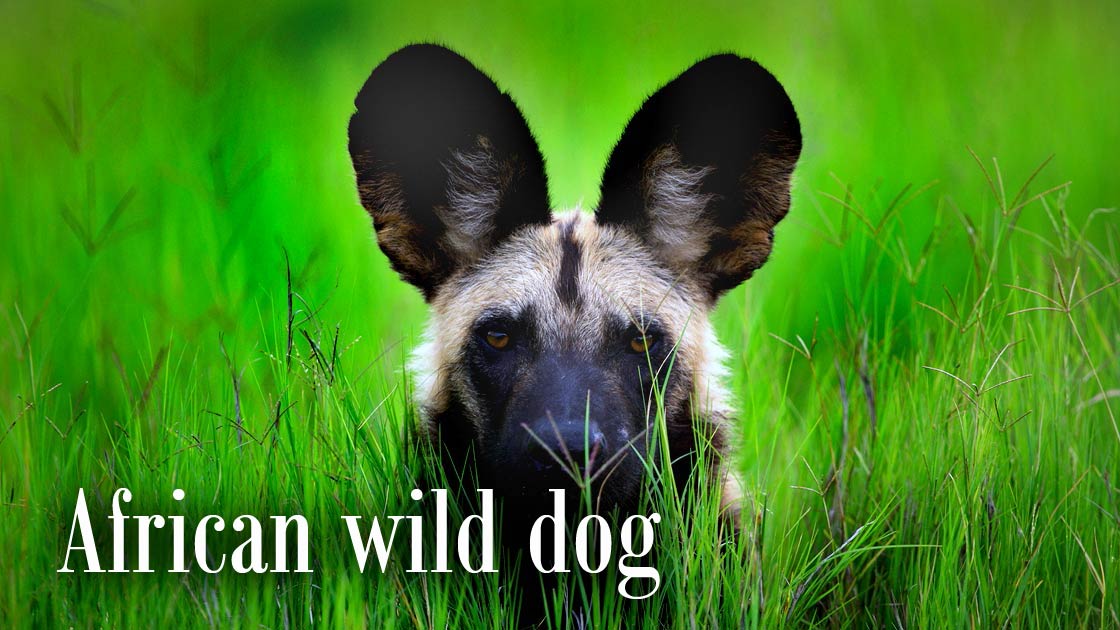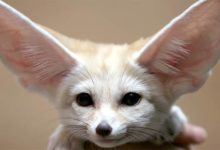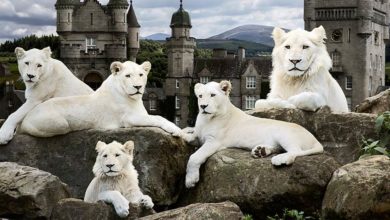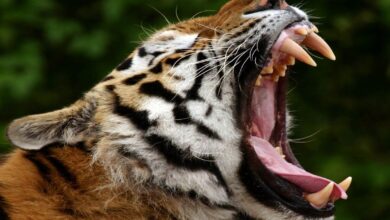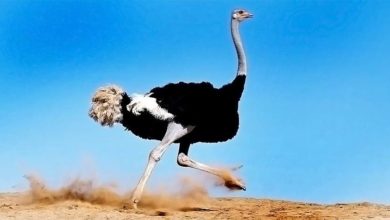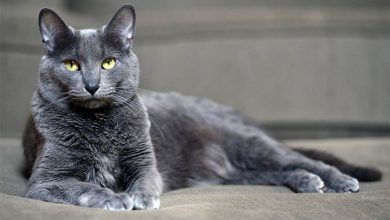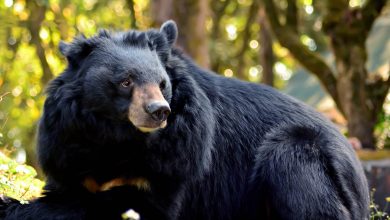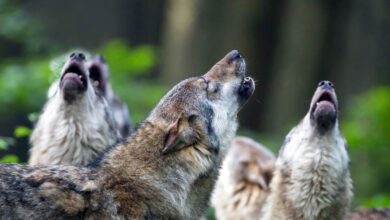African wild dog, painted dog, Cape hunting dog (Lycaon pictus)
African wild dogs, painted dogs (Lycaon pictus) Although the African wild dog has its roots in Eurasia, today it occurs only in Africa and is endangered. It has many names due to its distinctive, mottled coat. The African wild dog (also known as the painted dog or Cape hunting dog) is a canid, somewhat similar to the hyena, and forms social bonds stronger than the gray wolf (Canis lupus). Fierce, yet family-oriented and intelligent.
Classification
- Kingdom: Animalia
- Class: Mammalia
- Order: Carnivora
- Suborder: Caniformia
- Family: Canidae
- Genus: Lycaon
- Species: African wild dog (Lycaon pictus)
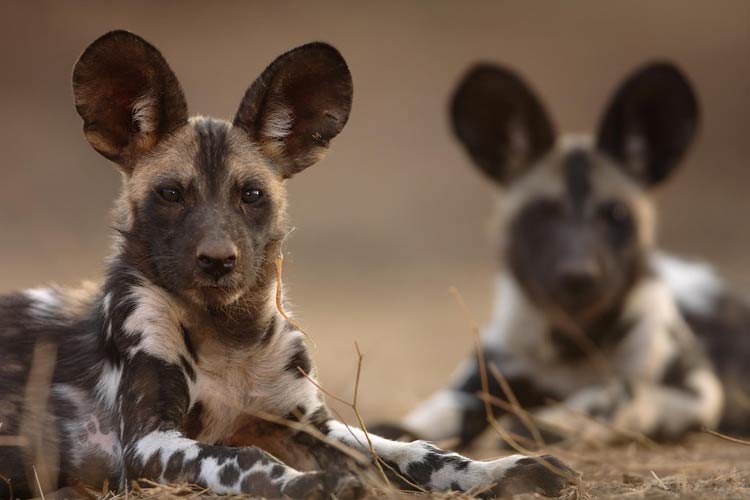
Distribution
In the past, the African wild dog inhabited 39 African countries, with a total population of approximately 500,000 individuals. Today, there are between 5,000 and 6,600 individuals remaining in fewer than 25 countries (it is believed that their habitats exist in only 14 African countries).
They can primarily be found in East and Southern Africa, mainly in two major populations: in Tanzania, within the Selous Game Reserve, and on the border between northern Botswana and eastern Namibia. Smaller populations find refuge in Zimbabwe, in Hwange National Park, as well as in Kruger National Park in South Africa. They also occur in Mozambique, Kenya, and Zambia. They thrive in the deciduous woodlands of the Serengeti in Tanzania, as there is a lack of competition from other predators. They can also establish secure dens there. Outside of the Serengeti, the African wild dog inhabits open grasslands: savannas and semi-deserts, as these are the habitats of their potential prey: herbivores such as zebras and wildebeest.
The average range size of African wild dogs in the Serengeti is estimated at 1,500 km² (approximately 579 sq mi).
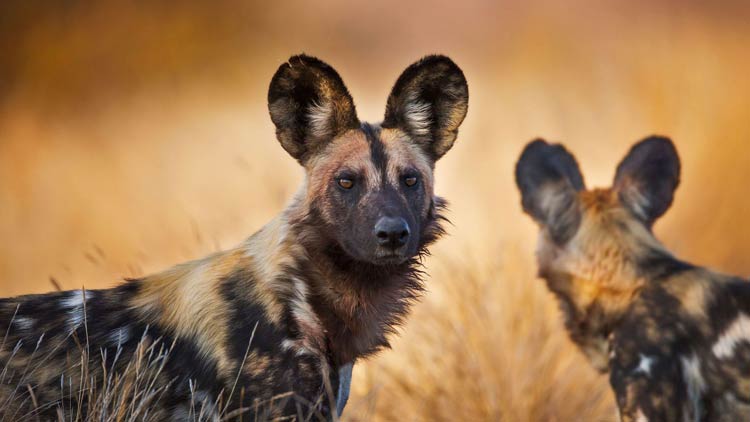
Characteristics
Appearance and Anatomy
The African wild dog is the largest African member of the canid family. Within the entire family, only the gray wolf (Canis lupus) is larger. The African wild dog is therefore the second-largest living wild canid in the world. It has a proportionally built body. Sexual dimorphism is practically non-existent. The ears are round, wide, and large, the muzzle is short, narrowing towards the nose. It has a highly developed nasal area, which is associated with an excellent sense of smell.
The skull is round, with wide jaw bones. It has enormous canines and carnassials (premolars adapted for shearing meat). The molars are large and broad, adapted for crushing bones. The neck muscles are similarly structured and attached to the occipital bone as in hyenas. The bite itself is very powerful. The legs are slender and long. The chest is narrow but strong and very capacious.
The entire muzzle, including the inner side of the ears, is black, with a dark streak on the forehead. The coat has a characteristic color pattern. Each African wild dog has a black and chestnut base coloration with white and rust-colored patches. The tail is bushy with a white tip.
Due to each individual having a unique pattern of spots on its coat, no two African wild dogs are alike. In some areas, the fur is so sparse that the multicolored skin is visible, and its shades determine the individual color pattern on the coat of a given pack member. Young African wild dogs have black fur with white markings.
The African wild dog lacks a vestigial fifth digit (dewclaw) on its front paws. It is one of the animals that secrete a strong musky odor.
The specific body structure, manifested, among other things, in the length of the fur and large ears, are features that allow the African wild dog to thrive in the grasslands around the Tropics, as the body does not overheat during long chases after prey because excess heat is constantly dissipated.
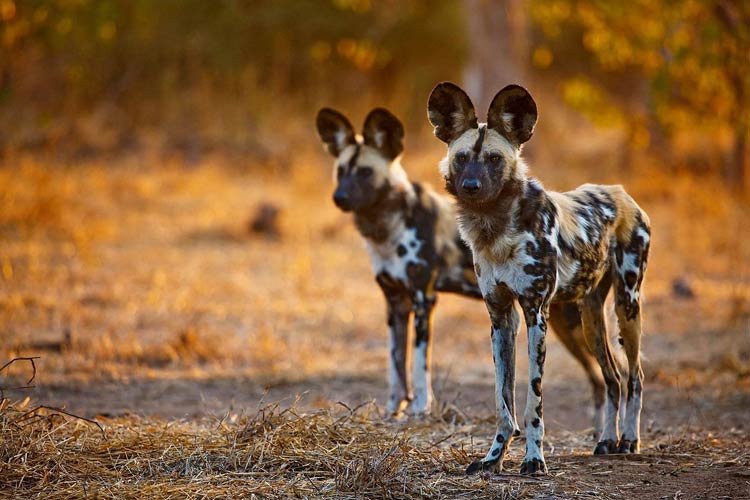
Diet and Hunting
They typically prey on medium-sized to large ungulates, such as Thomson’s gazelles, impalas, wildebeest, springbok, reedbucks (Redunca species), kudus, zebras, and even warthogs, giraffes, African buffalo, and occasionally ostriches. The larger the prey, the larger the pack required to subdue it.
African wild dogs always hunt in packs or small groups. Like all wild canids, they are adapted for long pursuits of their chosen prey. They are very persistent and can pursue prey for several kilometers. They have very complex hunting strategies – each member of the pack plays a different role during the capture of the vulnerable prey.
When attacking a large animal (wildebeest, zebra, African buffalo), African wild dogs appear suddenly, causing panic. In the confusion, it is easier to target a weaker or lost individual. Once the prey is surrounded, one African wild dog grabs it by the tail, another by the upper lip, nose, or throat, and the rest of the group attempts to tear and disembowel the prey while it is still alive. The hunters hold the prey’s nose, which, despite being exhausted from the chase, can still be dangerous. During the ambush, African wild dogs communicate verbally with each other to coordinate the efforts of the entire group.
After a successful hunt, the hunters return to their dens, located in caves or burrows, and provide food to those members who did not participate in the hunt. Hunting males regurgitate food so that the dominant female, pups, injured, sick, and old pack members can feed.
The hunting success of African wild dogs is influenced by several factors, including the type of prey they target, the density of vegetation in their environment, and the size of their pack. Generally, African wild dogs are highly effective hunters, achieving a success rate of over 60% in their pursuits. In some instances, this rate can soar to as high as 90%.
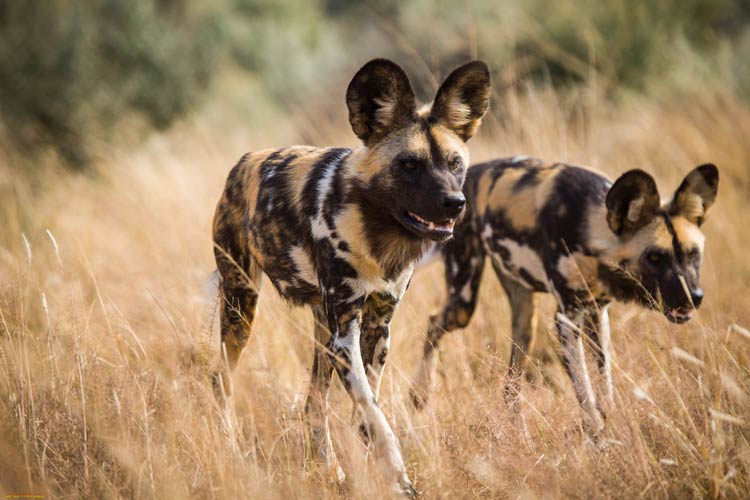
Pack Social Structure
In the past, it was claimed that if the alpha individual died, the pack would disband. However, this has not been recognized as a rule, but rather as an exception. In the event of the death of the dominant pair, African wild dogs are able to establish new leaders.
Within the pack, there is a division into a female group, led by the alpha female, and a male group, under the rule of the alpha male. In the female community, the oldest female—the mother—gains the status of the dominant female and will dominate her daughters and sisters. In the case of males, the father and the brother showing the greatest charisma are the dominants. When the father or brother is no longer present, another individual from the pack can become the new dominant. Younger males have priority during feeding, which allows for the formation of a hierarchy and the assumption of roles within the pack without bloodshed.
When a pack of males meets a pack of females, the animals can merge into an unrelated pack. Dominance is established without the use of violence. It often happens that the hierarchy is based on submission, not dominance. Lower-ranking members show their submission in a very friendly manner at every opportunity. It is suspected that this bloodless resolution of “conflicts of interest” is conditioned by the care of the young. If there were bloody clashes in every situation, in which members would die, the reduced pack would have a smaller chance of protecting them and securing sufficient food.
African wild dogs not associated with any pack sometimes join a foreign pack, but this is usually a temporary attachment. It also happens that foreign individuals try to take over a pack.
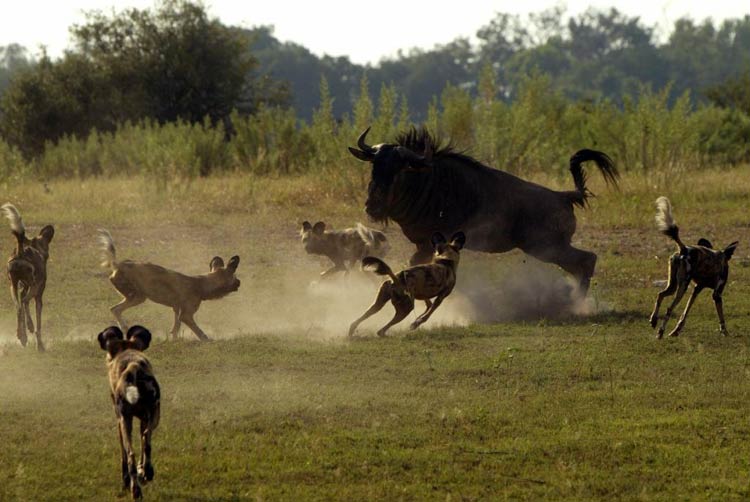
Reproduction
African wild dogs reproduce throughout the year, but the peak breeding season is between March and June. Copulation is brief to minimize the risk of attack from other predators. A single litter can contain from 2 to 19 pups, but usually consists of 10 young.
Litters are born at 12–14 month intervals, but this can be as short as 6 months if many pups from the previous litter have died. Gestation lasts approximately 70 days. The young are born in dens dug and abandoned by other animals, such as the aardvark (Orycteropus afer). Lactation lasts approximately 10 weeks. After 3 months, the young leave the den and begin life within the adult African wild dog community.
At 8–11 months of age, young African wild dogs already hunt small animals. They become fully fledged hunters at 12–14 months. They reach sexual maturity between 12 and 18 months. Young females disperse between 14 and 30 months of age and join other packs of not yet mature females.
Males usually do not leave their natal pack. This is unusual among social species, as females are usually the core of the community.
Female African wild dogs compete for males who will help them raise offspring. In an average community, there are two males for every female, and only dominant females can usually raise young. This may be because litters are not very large or scattered within the pack, which ensures a harmonious and cohesive structure. Interestingly, both females and males can be caregivers for the pups, and both sexes can also participate in hunts.
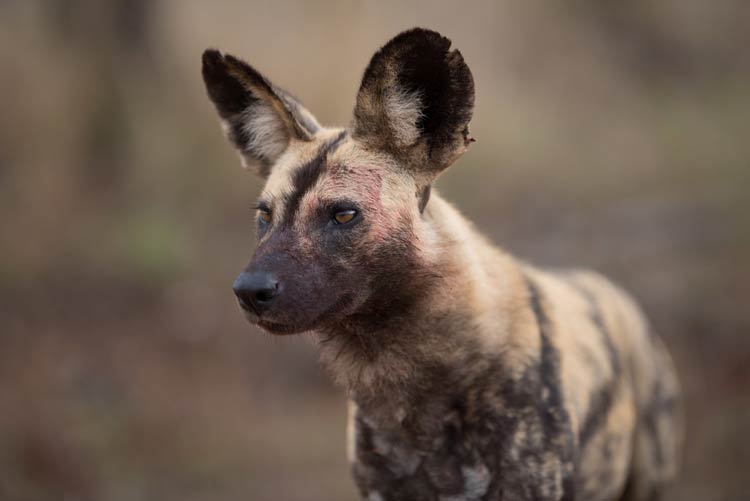
Detailed data / Dimensions / Size
African wild dog, painted dog (Lycaon pictus)
- Height: 60 – 75 cm (1 ft 11 in – 2 ft 6 in)
- Body length: 75 – 112 cm (2 ft 6 in – 3 ft 8 in)
- Tail length: 30 – 45 cm (approximately 12 – 18 in)
- Weight: 18 – 36 kg (approximately 40 – 79 lb)
- Speed:
- Maximum up to 65 km/h (40 mph).
- Over a distance of up to 5 km (3.1 mi), they can run at a speed of approximately 50 km/h (31 mph).
- Average chase covers some 2 km (1.2 mi)
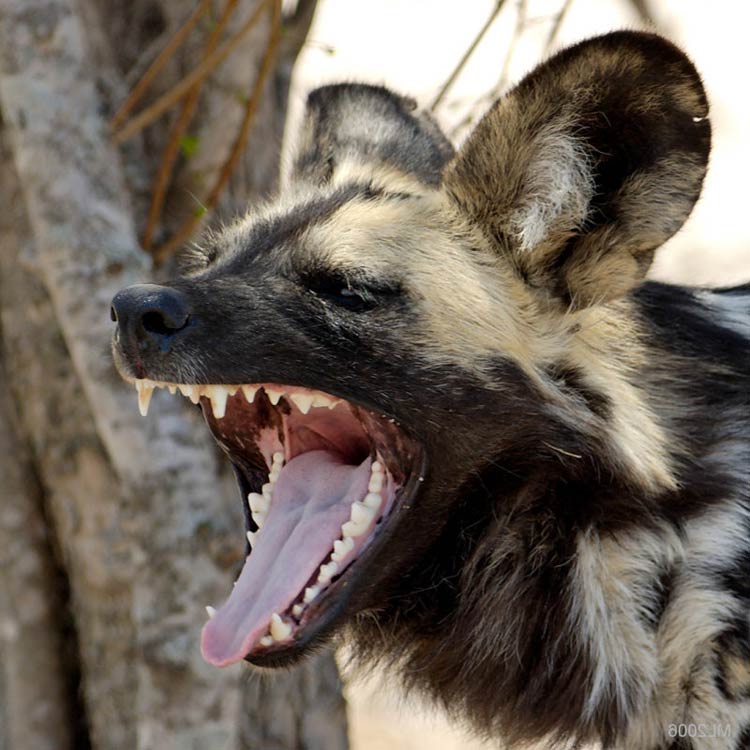
African wild dog – interesting facts
- African wild dogs are fearless hunters – they can run at a speed of 50 km/h (approximately 31 mph) over a distance of approximately 5 km (approximately 3.1 mi). They catch most prey within a distance of approximately 3 km (approximately 1.9 mi).
- African wild dogs hunt with an 80% success rate, in comparison – lions are successful in approximately 30% of their hunts.
- Relative to their body mass, African wild dogs have very powerful jaws. Only the Tasmanian devil surpasses them in this ranking.
- The hunting tactics for large animals may not be determined by instinct, but by learning and passing this knowledge from generation to generation.
- The average range size of African wild dogs in the Serengeti is estimated at 1,500 km² (approximately 579 sq mi).
- The voice of the African wild dog somewhat resembles the sound made by birds – it is melodic, sometimes high-pitched.
- Males are 3–7% larger than females.
- The African wild dog has 42 teeth.
- Packs of African wild dogs number from 10 to 60 members.
- The African wild dog is endangered.
- In Greek mythology, Lycaon was a wicked king of Arcadia, whom – for macabre transgressions – an angered Zeus turned into a wolf.
- Lycaon is also the name of a Japanese alternative metal band.
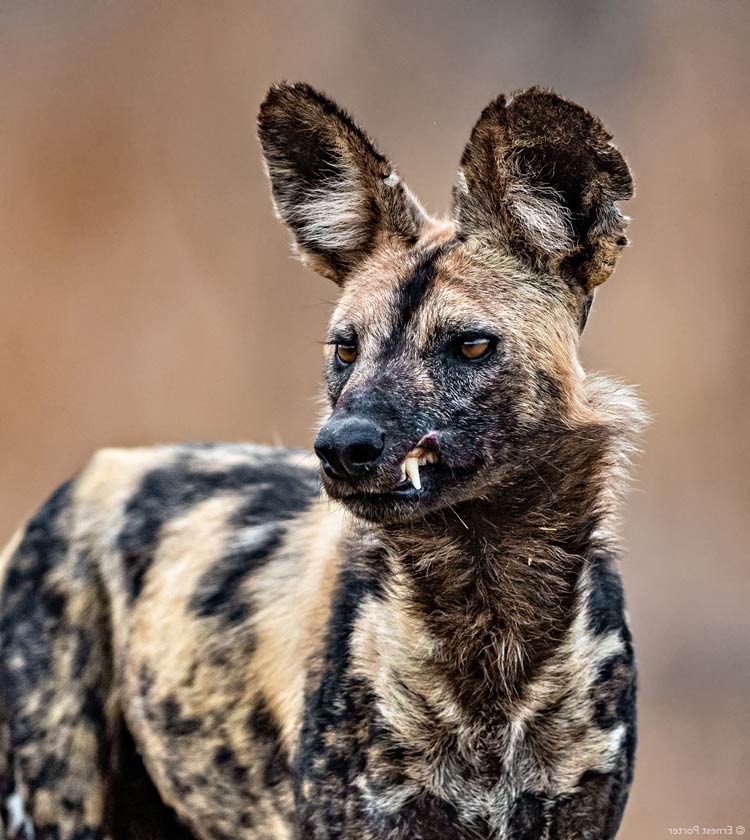
Recommended
- Maned wolf
- Asian golden cat
- Lion vs tiger
- Tsavo lions
- Barbary lion
- Siberian tiger
- Bengal tiger
- Sumatran tiger
- Indochinese tiger
- Malayan tiger
- Tigers
- White tigers
- Lions
- White lions
- Liger
- Animal fights
- American lion
- European cave lion
- Smilodon – Saber-toothed tiger
- Big cats
- Black panther
- Leopard
- Snow leopard
- African Lion
- Fastest animals
- Fastest birds

